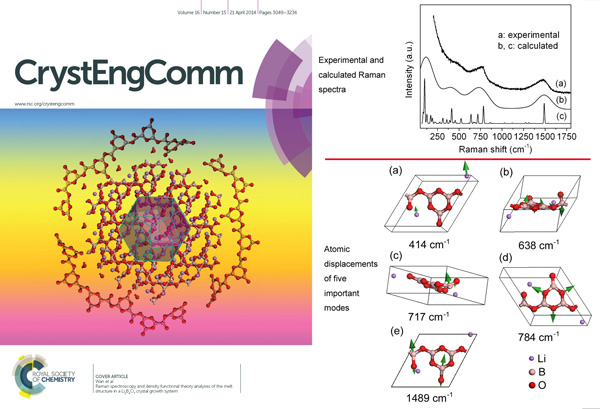Borate crystals were widely used as nonlinear optical, laser and luminescent materials due to their diversified structures and good chemical and physical properties. The growth of high-quality crystals is the key to their applications. The melt structure is a fundamental problem for the researches of borate crystal growth. It is related not only to the macro-properties of the melt, but also to the micro-process of the crystal growth. However, the understanding about borate melt structures is still very limited because of the complexity of the high-temperature melt structures and the lack of effective experimental techniques and theoretical analysis methods.
Recently, Prof. Wan Songming’s team in Anhui Institute of Optics and Fine Mechanics, Chinese Academy of Sciences, proposed a new idea for the study of borate melt structures. They deemed that a melt structure can be deduced from the crystal structure and its structural evolution during the melting process. Density functional perturbation theory (DFPT) calculations have also been used in the melt structure analysis for the first time. Wan et al studied the melt structures of BiB3O6 and Li2B4O7 by high-temperature Raman spectroscopy and CASTEP (Cambridge Sequential Total Energy Package) calculations. Both of the works were published in the famous international journal CrystEngComm. Reviewers considered that these works provided a universal method for the study of complex melt structures, and they are new breakthroughs in the field of melt structure researches. The study on the Li2B4O7 melt structure was published in CrystEngComm as a cover article on April 21.
By high-temperature Raman spectroscopy, Wan et al recorded in-situ the structural information during the melting of BiB3O6 and Li2B4O7 crystals, and found that the coordination number of the boron atoms changed from 4 to 3. According to the melt Raman spectrum characteristics, polymer-like boron-oxygen chains were proposed to describe the BiB3O6 and Li2B4O7 melt structures; their basic structural units were [B3O5Ø2/2]n and [B4O6Ø2/2]n respectively. Based on the structural units, they calculated the Raman spectra of the BiB3O6 and Li2B4O7 melts. The calculated results were in good agreement with the experimental, and gave clear assignments of some important melt Raman peaks. The above viewpoint and method lay a new foundation for the study of melt structures in complex systems, and are expected topromotethe development of the basic theory and experimental techniques of crystal growth.
These works are financially supported by the National Natural Science Foundation of China (grant No.50932005 and No. 51372246).

The links to the papers:
http://pubs.rsc.org/en/content/articlepdf/2013/ce/c2ce26742j
http://pubs.rsc.org/en/content/articlepdf/2014/ce/c3ce42544d